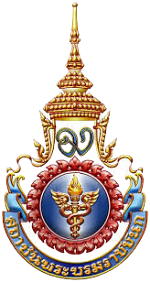ปัจจัยที่มีความสัมพันธ์กับภาวะหมดไฟในการทำงานของบุคลากรสาธารณสุข จังหวัดภูเก็ต
คำสำคัญ:
ภาวะหมดไฟในการทำงาน, บุคลากรสาธารณสุข, ภูเก็ตบทคัดย่อ
การวิจัยเชิงสำรวจแบบภาคตัดขวาง (Cross-sectional Survey Research) ครั้งนี้ มีวัตถุประสงค์ เพื่อศึกษาปัจจัยที่มีความสัมพันธ์กับภาวะหมดไฟในการทำงานของบุคลากรสาธารณสุขจังหวัดภูเก็ต จำนวน 302 คน ตัวอย่างได้แก่ บุคลากรในสังกัดสำนักงานสาธารณสุขจังหวัดภูเก็ต 7 แห่ง คือ สำนักงานสาธารณสุขจังหวัดภูเก็ต โรงพยาบาลป่าตอง โรงพยาบาลถลาง โรงพยาบาลฉลอง สำนักงานสาธารณสุขอำเภอเมืองภูเก็ต สำนักงานสาธารณสุขอำเภอกะทู้ และสำนักงานสาธารณสุขอำเภอถลาง โดยใช้แบบสอบถามเป็นเครื่องมือ ในการเก็บรวบรวมข้อมูล วิเคราะห์ข้อมูลด้วยสถิติเชิงพรรณนาและสถิติเชิงอนุมาน ได้แก่ การแจกแจงความถี่, ร้อยละ, ค่าเฉลี่ย, ส่วนเบี่ยงเบนมาตรฐาน, Chi-square และ Pearson Product-Moment Correlation
ผลการวิจัยพบว่า กลุ่มตัวอย่างมีภาวะหมดไฟระดับสูง (ร้อยละ 29.5) และระดับต่ำ – ปานกลาง (ร้อยละ 70.5) ปัจจัยที่มีความสัมพันธ์กับภาวะหมดไฟในบุคลากรด้านสาธารณสุข จังหวัดภูเก็ต ได้แก่ อายุ (p-value = 0.035) รายได้เฉลี่ยต่อเดือน ( p-value = 0.043) ตำแหน่งงาน (p-value = 0.007) การสูบบุหรี่ (p-value = 0.025) การดื่มแอลกอฮอล์ (p-value = 0.038) คุณภาพการนอน (p-value = 0.031) ความเครียด (p-value = 0.031) การรับรู้ความสามารถของตนเอง (r = -0.202, p-value <0.001) ปัจจัยการทำงาน พบว่า ปริมาณงาน (r = -0.143, p-value = 0.013) ลักษณะงานที่รับผิดชอบ (r = -0.208, p-value < 0.001) นโยบายขององค์กร (r = -0.246, p-value < 0.001) ปัจจัยการสนับสนุนทางสังคม พบว่า ครอบครัว (r = -0.144, p-value = 0.012) เพื่อน (r = - 0.200, p-value < 0.001) คนสำคัญหรือคนพิเศษ (r = -0.157, p-value = 0.006)
ดังนั้น ควรจัดโครงการตรวจประเมินสุขภาพจิตในกลุ่มบุคลากรที่มีภาวะหมดไฟในระดับสูง หากพบกลุ่มที่มีโรคทางจิตเวชร่วม ควรส่งต่อเพื่อทำการรักษา ส่วนกลุ่มที่ไม่พบโรคทางจิตเวชร่วม ควรจัดให้มีกิจกรรมหรือรูปแบบการทำงานที่ ลดภาวะหมดไฟต่อไป
คำสำคัญ: ภาวะหมดไฟในการทำงาน, บุคลากรสาธารณสุข, ภูเก็ต
เอกสารอ้างอิง
Alexander, A., De-Smet, A., Langstaff, M., & Ravid, D. (2021). What employees are saying about the future of remote work. McKinsey & Company.
Amiri, M., Vahedi, H., Mirhoseini, S. R., Eghtesadi, A. R., & Khosravi, A. (2019). Study of the relationship between self-efficacy, general health and burnout among Iranian health workers. Osong Public Health and Research Perspectives, 10(6), 359.
Ampornmunee, N. (2021). Prevalence and associated factors of burnout syndrome in inquiry officials in the metropolitan police bureau. Journal of the Psychiatric Association of Thailand, 66(1), 39-52.
Bartz, A. E. (1999). Basics statistical concepts. 4th ed. New Jersey: Prentice Hall.
Best, J. W. (1977). Research in education. 3rd ed. Englewood Cliffs, New Jersey: Prentice Hall, Inc.
Bumrungphanichthaworn, T., Jaidee, W., Wattanaburanon, A. Maharachpong, N. (2022). Factors related to burnout of worker in community hospital on pandemic COVID-19. The Public Health Journal of Burapha University, 17(1), 100-110.
Choon-ngarm, N. (2020). Mental health and burnout among physicians in general hospital and community hospital in Nakhon Ratchasima province. Journal of Mental Health of Thailand, 28(4), 348-59.
Chutchaikulsiri, P. (2021). Prevalence of burnout syndrome and its related risk factors among healthcare workers of Prasat Neurological Institute during Coronavirus (COVID-19) pandemic. Journal of the Psychiatric Association of Thailand, 66(4), 439-454.
Daniel, W. W. (1991). A foundation for analysis in the health sciences. Biostatistics Toronto.
John Wiley & Sons. De-Hert, S. (2020). Burnout in healthcare workers: prevalence, impact and preventative strategies. Local and Regional Anesthesia, 171-183.
Department of Mental Health (2020). Burnout in the city. Retrieved from https://dmh.go.th/News-Dmh/View.As p?Id=30176. (in Thai)
Junyotha, A., Chantanakul, S., Chaikittiporn, C., & Siri, S. (2017). Fatigue and factors related to fatigue among registered nurses in a tertiary hospital. Journal of The Royal Thai Army Nurses, 18(Special edition), 166-174.
Galaiya, R., Kinross, J., & Arulampalam, T. (2020). Factors associated with burnout syndrome in surgeons: a systematic review. Annals of the Royal College of Surgeons of England, 102(6), 401-407. https://doi:10.1308/rcsann.2020.0040.
Gallup, I. (2022). State of the global workplace report. Retrieved July 21, 2024. From https://www.gallup.com/Workplace/349484/State-Of-The-Global-Workplace.Aspx#Ite-506891. (in Thai)
Green, P., Martin, D., & White, S. (2022). Age, tenure, and personal accomplishment in educational institutions. Educational Research Quarterly, 48(2), 215-229.
Kittiban, K., Cheevakasemsook, A., & Phuangsomjit, C. (2021). Occupational fatigue management in professional nurses at Phra Nakhon Si Ayutthaya hospital. Thai Journal of Cardio- Thoracic Nursing, 32(1), 121-136.
Ketchaikosol, P. (2021). Job burnout among generation y in company employees. (Master of Management). Mahidol University, Retrieved from https://archive.cm.mahidol.ac.th/bitstream/123456789/4127/1/TP%20BM.038%202564. pdf. (in Thai)
Nakawiro, D. (2021). Burnout syndrome. Retrieved July 21, 2024. From https://www.rama.mahidol.ac.th/ramachannel/gallery/ burnout -syndrome/
Phetsri, C. (2023). Factors related to burnout syndrome among healthcare worker of Chana community hospital, Songkhla Province. Journal of Health and Environmental Education, 8(3), 701-704.
Ratchanipon, S. (2023). Factors related to work fatigue among health service network personnel in La-un District, Ranong province. Journal of Graduate Studies for Lifelong Learning, 1(1), 50-64.
Ritsamret, N., Thammakun, T., & Laoraksawong, P. (2022). Factors related to burnout syndrome among personnel in the private hospitals, Mueang Chon Buri district, Chon Buri province. The Public Health Journal of Burapha University, 17(1), 86-99.
Sinutpattanasuk, P. & Wijitraphan, T. (2022). Risk factors of job burnout among personnel of Sanpatong hospital, Chiangmai province. Journal of Health Science, 31(1), 154-163.
Sirirat, P. (2021). Job burnout among baby boomers in state-entwrprise employees. (Thesis, master of management degree, college of management). Nakhon Phatom, Mahidol University. (in Thai)
Shanafelt, T. D., Boone, S., Tan, L., Dyrbye, L. N., Sotile, W., Satele, D., Oreskovich, M. R. (2012). Burnout and satisfaction with work-life balance among US physicians relative to the general US population. Archives of Internal Medicine, 172(18), 1377-1385.
Thawornwong, P. (2021). Work fatigue of personnel at Phraphrom contracting unit for primary care, Nakhon Si Thammarat province. Region 11 Medical Journal, 35(1), 1-14
Travelperk. (2023). Global workplace burnout statistics. Retrieved July 21, 2024. from https://www.travelperk. com /Blog/Remote-Work-Burnout-Statistics/. (in Thai)
Woraphongsathorn, S. (2015). Research in health education. Bangkok. Printing section Ramkhamhaeng University. (in Thai)

ดาวน์โหลด
เผยแพร่แล้ว
รูปแบบการอ้างอิง
ฉบับ
ประเภทบทความ
สัญญาอนุญาต
ลิขสิทธิ์ (c) 2024 วิทยาลัยพยาบาลบรมราชชนนี นครศรีธรรมราช

อนุญาตภายใต้เงื่อนไข Creative Commons Attribution-NonCommercial-NoDerivatives 4.0 International License.
บทความที่ได้รับการตีพิมพ์เป็นลิขสิทธิ์ของ วิทยาลัยพยาบาลบรมราชชนนี นครศรีธรรมราช
ข้อความที่ปรากฏในบทความแต่ละเรื่องในวารสารวิชาการเล่มนี้เป็นความคิดเห็นส่วนตัวของผู้เขียนแต่ละท่านไม่เกี่ยวข้องกับวิทยาลัยพยาบาลบรมราชชนนี นครศรีธรรมราช และบุคคลากรท่านอื่น ๆ ในวิทยาลัยฯ แต่อย่างใด ความรับผิดชอบองค์ประกอบทั้งหมดของบทความแต่ละเรื่องเป็นของผู้เขียนแต่ละท่าน หากมีความผิดพลาดใดๆ ผู้เขียนแต่ละท่านจะรับผิดชอบบทความของตนเองแต่ผู้เดียว





